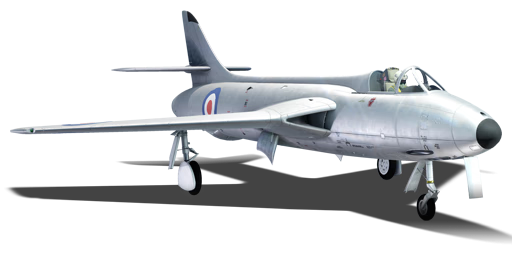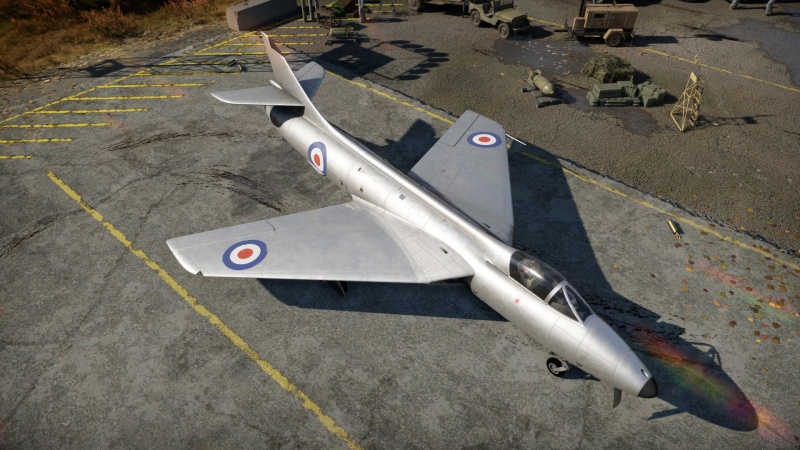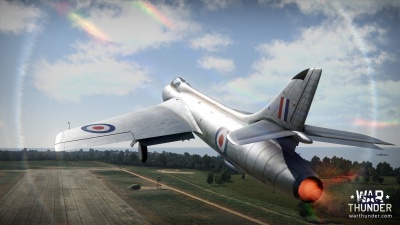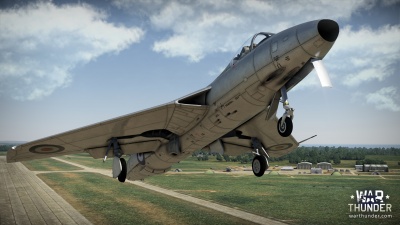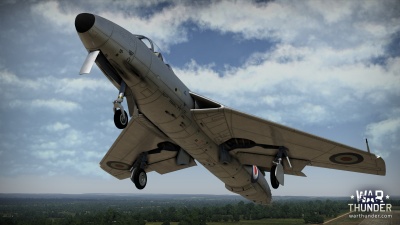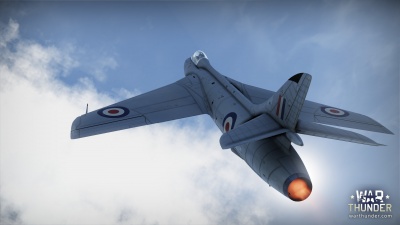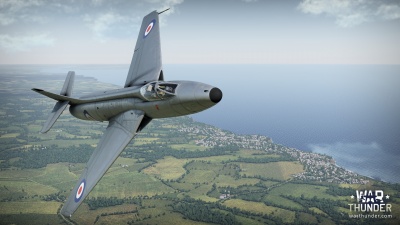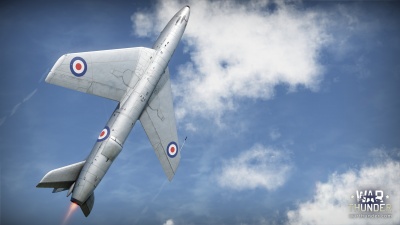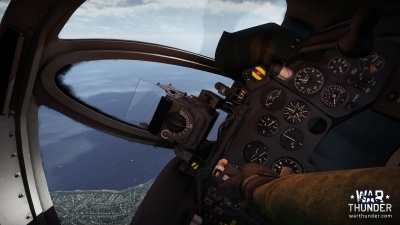Difference between revisions of "Hunter F.1"
m (→Flight performance) |
(Edits) |
||
| Line 20: | Line 20: | ||
<!-- ''Describe how the aircraft behaves in the air. Speed, manoeuvrability, acceleration and allowable loads - these are the most important characteristics of the vehicle.'' --> | <!-- ''Describe how the aircraft behaves in the air. Speed, manoeuvrability, acceleration and allowable loads - these are the most important characteristics of the vehicle.'' --> | ||
| − | The Hawker Hunter is a transonic jet fighter, | + | The Hawker Hunter is a transonic jet fighter, powered by the Rolls-Royce Avon Mk.113 engine. It is able to reach 1,109 km/h at sea level and 1,013 km/h at 9,000 m, very similar to the [[F-86 (Family)|F-86F]] series. It can reach 1.0 Mach in dive and be able to recover from it. |
| − | Its | + | Its thrust to weight ratio is 0.50 with fuel tanks and 0.57 with 5 minutes of fuel, making the level acceleration very good. The climb rate is also good, 55 m/s at sea level, but in order to achieve it the Hunter needs to keep 920 km/h TAS, it is better in comparison to other jets without an afterburner like a F-86F or MiG-17. |
| − | The engine might start overheating after 10 minutes of flying at 100% | + | The engine might start overheating after 10 minutes of flying at 100%, which can be mitigated by setting RPM to 7550 or lower. |
| − | Despite having low wing loading compared to other jets it is not | + | Despite having low wing loading compared to other jets it is not particularly manoeuvrable and has a high stall speed, due to the low amount of lift generated by its wings. While its high speed turn rate is decent and the plane can pull up to ~12 G, once the plane decreases its speed to around 700 km/h it begins to struggle and it only gets worse the slower it flies. Outturning any Sabre or MiG-15 is not possible and the plane will have a hard time even against planes like the F11F-1. |
| − | The elevator starts to lock up above 0.85 Mach, below that speed it should be able to pull at least 11G. Its roll rate is decent and just good enough to make flying it comfortable, ~120°/s at 900 km/h, ~105°/s at 600 km/h and ~50°/s at 300 km/h, making it better than the MiG-15bis or MiG-17, but worse than all American Sabres. The flaps can slightly improve the turning performance, however they can be used | + | The elevator starts to lock up above 0.85 Mach, below that speed it should be able to pull at least 11G. Its roll rate is decent and just good enough to make flying it comfortable, ~120°/s at 900 km/h, ~105°/s at 600 km/h and ~50°/s at 300 km/h, making it better than the MiG-15bis or MiG-17, but worse than all American Sabres. The flaps can slightly improve the turning performance, however they can only be used below 600 km/h IAS, where it struggles to turn. |
| − | The | + | The airbrake provides as much drag as in similar planes like the Sabre, but has one issue, it is located under the plane, so it cannot be deployed when the landing gear is extended. This can make landing quite tricky since its wheel brakes are also weak and landing speed is high: around 300 km/h IAS with flaps. |
| − | The Hunter is a very nice to fly plane in | + | The Hunter is a very nice to fly plane in both Realistic and Simulator battles, aiming is easy since it is very stable. A slight pitch trimming might be required to stop its nose from dropping, up to 3%. |
Reaching the maximum angle of attack will not make it start spinning immediately, that can happen only after a few seconds pulling it all the way to yourself, but it also can be easily recovered from that state. | Reaching the maximum angle of attack will not make it start spinning immediately, that can happen only after a few seconds pulling it all the way to yourself, but it also can be easily recovered from that state. | ||
| Line 49: | Line 49: | ||
|} | |} | ||
| − | ====Details==== | + | ==== Details ==== |
{| class="wikitable" style="text-align:center" width="50%" | {| class="wikitable" style="text-align:center" width="50%" | ||
|- | |- | ||
| Line 124: | Line 124: | ||
<!-- ''Examine the survivability of the aircraft. Note how vulnerable the structure is and how secure the pilot is, whether the fuel tanks are armoured, etc. Describe the armour, if there is any, and also mention the vulnerability of other critical aircraft systems.'' --> | <!-- ''Examine the survivability of the aircraft. Note how vulnerable the structure is and how secure the pilot is, whether the fuel tanks are armoured, etc. Describe the armour, if there is any, and also mention the vulnerability of other critical aircraft systems.'' --> | ||
| − | * 64 mm Bulletproof glass - | + | * 64 mm Bulletproof glass - Armoured windscreen |
| − | * 12.7 mm Steel - | + | * 12.7 mm Steel - Armour plate behind the pilot |
=== Modifications and economy === | === Modifications and economy === | ||
| Line 134: | Line 134: | ||
=== Offensive armament === | === Offensive armament === | ||
{{Specs-Avia-Offensive}} | {{Specs-Avia-Offensive}} | ||
| − | <!--''Describe the offensive armament of the aircraft, if any. Describe how effective the cannons and machine guns are in a battle, and also what belts or drums are better to use. If there is no offensive weaponry, delete this subsection.''--> | + | <!-- ''Describe the offensive armament of the aircraft, if any. Describe how effective the cannons and machine guns are in a battle, and also what belts or drums are better to use. If there is no offensive weaponry, delete this subsection.'' --> |
{{main|ADEN (30 mm)}} | {{main|ADEN (30 mm)}} | ||
| Line 142: | Line 142: | ||
== Usage in battles == | == Usage in battles == | ||
| − | <!-- ''Describe the tactics of playing in | + | <!-- ''Describe the tactics of playing in the aircraft, the features of using aircraft in a team and advice on tactics. Refrain from creating a "guide" - do not impose a single point of view, but instead, give the reader food for thought. Examine the most dangerous enemies and give recommendations on fighting them. If necessary, note the specifics of the game in different modes (AB, RB, SB).'' --> |
| − | The Hunter | + | The Hunter's main strengths are high top speed and good guns, making it a good Boom & Zoomer. |
| − | The Hunter is less | + | The Hunter is less manoeuvrable than the F-86 and MiG-15 while being the second fastest with a good thrust-to-weight ratio. However, the rate of climb is significantly worse than the other jets and so it requires some side climbing. Stay fast at all times and never drop beneath 850 TAS (~800 km/h in air). |
| − | The 30 mm ADEN cannon is an extremely powerful cannon. Being a revolver cannon, it fires extremely fast and has excellent ballistics. The Hunter F | + | The 30 mm ADEN cannon is an extremely powerful cannon. Being a revolver cannon, it fires extremely fast and has excellent ballistics. The Hunter F.1 has, thanks to mounting a pack of four ADEN 30 mm cannons, one of the highest one-second burst masses, near 21 kg/s. This weapon's characteristics mean that the 4 of them pose a serious threat for any aircraft that happens to be the target of them. The cannon, however, has the disadvantage of chewing very quickly through ammo thanks to its high rate of fire, so being wary of the ammo count is a necessity. The discrete tracer rounds may induce the player into error, causing the impression that only a light burst is being fired, however experience will quickly disprove anyone who thinks in this manner. |
| − | The armour-piercing rounds of the Hunter enable it to do some ground attack against light tanks, medium tanks, and pillboxes | + | The armour-piercing rounds of the Hunter enable it to do some ground attack against light tanks, medium tanks, and pillboxes. |
=== Pros and cons === | === Pros and cons === | ||
| − | <!-- '' | + | <!-- ''Summarise and briefly evaluate the vehicle in terms of its characteristics and combat effectiveness. Mark its pros and cons in the bulleted list. Try not to use more than 6 points for each of the characteristics. Avoid using categorical definitions such as "bad", "good" and the like - use substitutions with softer forms such as "inadequate" and "effective".'' --> |
'''Pros:''' | '''Pros:''' | ||
| Line 178: | Line 178: | ||
== History == | == History == | ||
| − | <!-- ''Describe the history of the creation and combat usage of the aircraft in more detail than in the introduction. If the historical reference turns out to be too | + | <!-- ''Describe the history of the creation and combat usage of the aircraft in more detail than in the introduction. If the historical reference turns out to be too long, take it to a separate article, taking a link to the article about the vehicle and adding a block "/History" (example: <nowiki>https://wiki.warthunder.com/(Vehicle-name)/History</nowiki>) and add a link to it here using the <code>main</code> template. Be sure to reference text and sources by using <code><nowiki><ref></ref></nowiki></code>, as well as adding them at the end of the article with <code><nowiki><references /></nowiki></code>. This section may also include the vehicle's dev blog entry (if applicable) and the in-game encyclopedia description (under <code><nowiki>=== In-game description ===</nowiki></code>, also if applicable).'' --> |
In the aftermath of the second world war the Air Ministry issued Specification E.38/46 for a swept wing research aircraft that was fulfilled by a modified Hawker Sea Hawk (P.1052). The experimental aircraft showed an jump in high speed performance and as a result Hawker went forward to modify the second P.1052 into the P.1081. With a swept tail plane and the engine exhaust now located at the rear of the fuselage instead of the split exhaust further improving performance, it attracted the RAAF. The P.1081 gave Hawker useful information for the development of the Hunter. | In the aftermath of the second world war the Air Ministry issued Specification E.38/46 for a swept wing research aircraft that was fulfilled by a modified Hawker Sea Hawk (P.1052). The experimental aircraft showed an jump in high speed performance and as a result Hawker went forward to modify the second P.1052 into the P.1081. With a swept tail plane and the engine exhaust now located at the rear of the fuselage instead of the split exhaust further improving performance, it attracted the RAAF. The P.1081 gave Hawker useful information for the development of the Hunter. | ||
Revision as of 23:20, 14 March 2021
| This page is about the British jet fighter Hunter F.1. For other versions, see Hunter (Family). |
Contents
Description
The Hunter F.1 is a rank VI British jet fighter with a battle rating of 9.0 (AB/RB/SB). It was introduced in Update 1.53 "Firestorm".
The Hawker Hunter is the iconic 1950s British swept-wing fighter. Produced from a requirement for a jet interceptor dating back to 1946 it fulfilled its role with outstanding success. Able to deliver a punishing blow with its four 30 mm ADEN cannons and manoeuvrability at high speed, it is a very capable jet. The F.1 follows the Vampire FB.1 and Venom FB.4 in the tree, providing an initial steep learning curve. Its calling card is sheer speed, with the Hunter able to go supersonic in dives once spaded.
General info
Flight performance
The Hawker Hunter is a transonic jet fighter, powered by the Rolls-Royce Avon Mk.113 engine. It is able to reach 1,109 km/h at sea level and 1,013 km/h at 9,000 m, very similar to the F-86F series. It can reach 1.0 Mach in dive and be able to recover from it. Its thrust to weight ratio is 0.50 with fuel tanks and 0.57 with 5 minutes of fuel, making the level acceleration very good. The climb rate is also good, 55 m/s at sea level, but in order to achieve it the Hunter needs to keep 920 km/h TAS, it is better in comparison to other jets without an afterburner like a F-86F or MiG-17. The engine might start overheating after 10 minutes of flying at 100%, which can be mitigated by setting RPM to 7550 or lower.
Despite having low wing loading compared to other jets it is not particularly manoeuvrable and has a high stall speed, due to the low amount of lift generated by its wings. While its high speed turn rate is decent and the plane can pull up to ~12 G, once the plane decreases its speed to around 700 km/h it begins to struggle and it only gets worse the slower it flies. Outturning any Sabre or MiG-15 is not possible and the plane will have a hard time even against planes like the F11F-1. The elevator starts to lock up above 0.85 Mach, below that speed it should be able to pull at least 11G. Its roll rate is decent and just good enough to make flying it comfortable, ~120°/s at 900 km/h, ~105°/s at 600 km/h and ~50°/s at 300 km/h, making it better than the MiG-15bis or MiG-17, but worse than all American Sabres. The flaps can slightly improve the turning performance, however they can only be used below 600 km/h IAS, where it struggles to turn. The airbrake provides as much drag as in similar planes like the Sabre, but has one issue, it is located under the plane, so it cannot be deployed when the landing gear is extended. This can make landing quite tricky since its wheel brakes are also weak and landing speed is high: around 300 km/h IAS with flaps.
The Hunter is a very nice to fly plane in both Realistic and Simulator battles, aiming is easy since it is very stable. A slight pitch trimming might be required to stop its nose from dropping, up to 3%. Reaching the maximum angle of attack will not make it start spinning immediately, that can happen only after a few seconds pulling it all the way to yourself, but it also can be easily recovered from that state.
| Characteristics | Max Speed (km/h at 0 m - sea level) |
Max altitude (metres) |
Turn time (seconds) |
Rate of climb (metres/second) |
Take-off run (metres) | |||
|---|---|---|---|---|---|---|---|---|
| AB | RB | AB | RB | AB | RB | |||
| Stock | 1,098 | 1,092 | 14000 | 32.0 | 33.3 | 44.6 | 40.7 | 820 |
| Upgraded | 1,117 | 1,108 | 30.1 | 31.0 | 65.8 | 55.0 | ||
Details
| Features | |||||
|---|---|---|---|---|---|
| Combat flaps | Take-off flaps | Landing flaps | Air brakes | Arrestor gear | Drogue chute |
| ✓ | ✓ | ✓ | ✓ | X | X |
| Limits | ||||||
|---|---|---|---|---|---|---|
| Wings (km/h) | Gear (km/h) | Flaps (km/h) | Max Static G | |||
| Combat | Take-off | Landing | + | - | ||
| 0 | 450 | 603 | 581 | 465 | ~11 | ~5 |
| Optimal velocities (km/h) | |||
|---|---|---|---|
| Ailerons | Rudder | Elevators | Radiator |
| < 850 | < 600 | < 650 | N/A |
Engine performance
| Engine | Aircraft mass | ||||
|---|---|---|---|---|---|
| Engine name | Number | Empty mass | Wing loading (full fuel) | ||
| Rolls-Royce Avon Mk.113 | 1 | 5,970 kg | 227 kg/m2 | ||
| Engine characteristics | Mass with fuel (no weapons load) | Max Takeoff Weight | |||
| Weight (each) | Type | 5m fuel | 18m fuel | ||
| 1,175 kg | Axial-flow turbojet | 6,310 kg | 7,169 kg | 9,530 kg | |
| Maximum engine thrust @ 0 m (RB / SB) | Thrust to weight ratio @ 0 m (100%) | ||||
| Condition | 100% | WEP | 5m fuel | 18m fuel | MTOW |
| Stationary | 3,283 kgf | N/A | 0.52 | 0.46 | 0.34 |
| Optimal | 3,585 kgf (1,100 km/h) |
N/A | 0.57 | 0.50 | 0.38 |
Survivability and armour
- 64 mm Bulletproof glass - Armoured windscreen
- 12.7 mm Steel - Armour plate behind the pilot
Modifications and economy
Armaments
Offensive armament
The Hunter F.1 is armed with:
- 4 x 30 mm ADEN cannons, chin-mounted (150 rpg = 600 total)
Usage in battles
The Hunter's main strengths are high top speed and good guns, making it a good Boom & Zoomer.
The Hunter is less manoeuvrable than the F-86 and MiG-15 while being the second fastest with a good thrust-to-weight ratio. However, the rate of climb is significantly worse than the other jets and so it requires some side climbing. Stay fast at all times and never drop beneath 850 TAS (~800 km/h in air).
The 30 mm ADEN cannon is an extremely powerful cannon. Being a revolver cannon, it fires extremely fast and has excellent ballistics. The Hunter F.1 has, thanks to mounting a pack of four ADEN 30 mm cannons, one of the highest one-second burst masses, near 21 kg/s. This weapon's characteristics mean that the 4 of them pose a serious threat for any aircraft that happens to be the target of them. The cannon, however, has the disadvantage of chewing very quickly through ammo thanks to its high rate of fire, so being wary of the ammo count is a necessity. The discrete tracer rounds may induce the player into error, causing the impression that only a light burst is being fired, however experience will quickly disprove anyone who thinks in this manner.
The armour-piercing rounds of the Hunter enable it to do some ground attack against light tanks, medium tanks, and pillboxes.
Pros and cons
Pros:
- Decent acceleration above 900 km/h
- Large and effective air brake
- Insanely good armaments; four 30 mm ADEN cannons shred everything in a short burst
- Very good energy retention
- Can out zoom climb MiG-17s and MiG-15bis
- Can outrun most contemporary jets on your six if put into a 10° climb
- Armament is capable of destroying tanks and light pillboxes
- New boosters modification allows it to make deflection shots at high speeds
- 30 mm cannons have a high rate of fire
- Very stable, makes aiming at any speed easy
Cons:
- Most jets in uptiers can out-speed, gain more energy, and out-turn the Hunter, or just use their air-to-air missiles
- AAMs (even AIM-9Bs and R-3Ss) nullify your speed advantage and force you to bleed speed to avoid them
- Nearly all supersonic jets will be very hard to face
- Doesn't have air-to-air missiles
- Worst jet in terms of 1 vs 1 due to the bad manoeuvrability; you will be left in desperation when the rest of the team is gone
- Poor performance in horizontal turning
- Large target, especially when turning
History
In the aftermath of the second world war the Air Ministry issued Specification E.38/46 for a swept wing research aircraft that was fulfilled by a modified Hawker Sea Hawk (P.1052). The experimental aircraft showed an jump in high speed performance and as a result Hawker went forward to modify the second P.1052 into the P.1081. With a swept tail plane and the engine exhaust now located at the rear of the fuselage instead of the split exhaust further improving performance, it attracted the RAAF. The P.1081 gave Hawker useful information for the development of the Hunter.
In 1946 the Air Ministry issued Specification F.43/46 that was later added to in 1948 by Specification F.3/48. This demanded a speed of 629 mph at 45,000 ft and a high rate of climb (as F.43/46 was for a jet powered interceptor), while carrying an armament of four 20 mm or two 30 mm cannons. Using what they had learnt from the P.1052 and P.1081 they produced the Prototype P.1067. The new prototype first flew with the Avon 103 engine in 1951 with a second powered by the Avon 107 in 1952.The Air Ministry ordered the Hunter into production in 1950 with the Avon 113 power plant. Thus the iconic Hawker Hunter was born.
The first production or pre-production F.1s entered service in 1953. The first was WT556 that entered service with A&AEE on the 16th of July 1953 and a further 15 delivered the same year. The Early F.1's featured boosted control surfaces but not the under belly air brake. The armament consisted of four 30 mm ADEN cannons with 150 rpg at 1200 rpm located under the nose.
Media
- Skins
- Images
- Hunter F.1 Devblog Images
- Videos
See also
- Related development
- Hawker Sea Hawk
- Hawker Hunter F.6
- Aircraft of comparable role, configuration and era
- Dassault Super Mystère
- Mikoyan MiG-17
- North American F-100 Super Sabre
- North American FJ-4B Fury
External links
- [Devblog] Yak-9B and Hawker Hunter F.1
- Official data sheet - more details about the performance
- Hawker Hunter F.1 forum thread
| Hawker Aircraft Limited | |
|---|---|
| Biplane fighters | |
| Fury | Fury Mk I · Fury Mk II |
| Nimrod | Nimrod Mk I · Nimrod Mk II |
| Scout plane | Osprey Mk IV |
| Piston fighters | |
| Hurricane | Hurricane Mk I/L · Hurricane Mk.I/L FAA M · Sea Hurricane Mk IB · Sea Hurricane Mk IC · Hurricane Mk IIB/Trop · Hurricane Mk IV |
| Typhoon | Typhoon Mk Ia · Typhoon Mk Ib · Typhoon Mk Ib/L |
| Tempest | Tempest Mk V · Tempest Mk V (Vickers P) · Tempest Mk II |
| Fury | Sea Fury FB 11 |
| Jet fighters | |
| Hunter | Hunter F.1 · Hunter F.6 · Hunter FGA.9 |
| Sea Hawk | Sea Hawk FGA.6 |
| Harrier | Harrier GR.1 · Harrier GR.3 |
| Export | ▄Hurricane Mk I/L · ▂Hurricane Mk IIB · ◘Sea Fury FB 51 |
| ◘Sea Hawk Mk.50 · ◄Sea Hawk Mk.100 · ◘Hunter F.6 · ◌Hunter F.58 · J34 · AV-8A · AV-8C · ▄AV-8S | |
| Captured | ▀Tempest Mk V |
| See Also | Fokker |
| Britain jet aircraft | |
|---|---|
| Blackburn | Buccaneer S.1 · Buccaneer S.2 · Buccaneer S.2B |
| British Aerospace | Harrier GR.7 · Sea Harrier FRS.1 (e) · Sea Harrier FRS.1 · Sea Harrier FA 2 |
| British Aircraft Corporation | Strikemaster Mk.88 |
| English Electric | Canberra B Mk 2 · Canberra B (I) Mk 6 · Lightning F.6 · Lightning F.53 |
| Gloster | Meteor F Mk 3 · Sea Meteor F Mk 3 · Meteor F Mk 4 G.41F · Meteor F Mk 4 G.41G · Meteor F Mk 8 G.41K · Meteor F Mk.8 Reaper |
| Javelin F.(A.W.) Mk.9 | |
| de Havilland | Vampire F.B.5 · Venom FB.4 · Sea Venom FAW 20 · Sea Vixen F.A.W. Mk.2 |
| Hawker | Sea Hawk FGA.6 · Hunter F.1 · Hunter F.6 · Hunter FGA.9 · Harrier GR.1 · Harrier GR.3 |
| Panavia | Tornado GR.1 · Tornado GR.4 · Tornado F.3 · Tornado F.3 Late |
| SEPECAT | Jaguar GR.1 · Jaguar GR.1A · Jaguar IS |
| Supermarine | Attacker FB 1 · Attacker FB.2 · Scimitar F Mk.1 · Swift F.1 · Swift F.7 |
| Foreign | Phantom FG.1 (USA) · Phantom FGR.2 (USA) · F-4J(UK) Phantom II (USA) |
| Australia | F-111C |
| India | ▄MiG-21 Bison |
| South Africa | ▄JAS39C |


